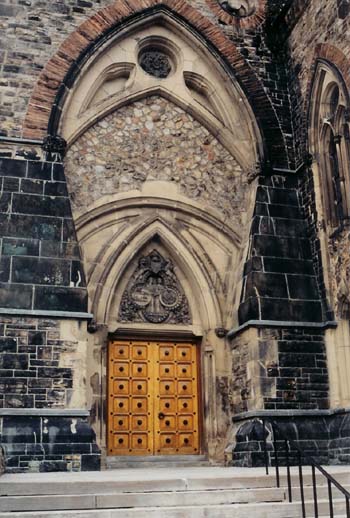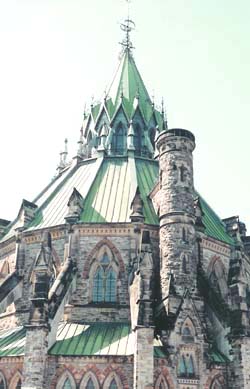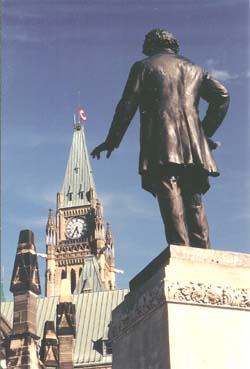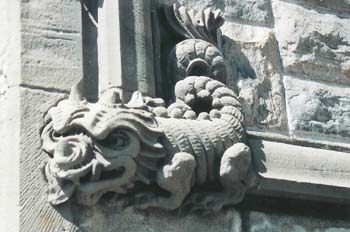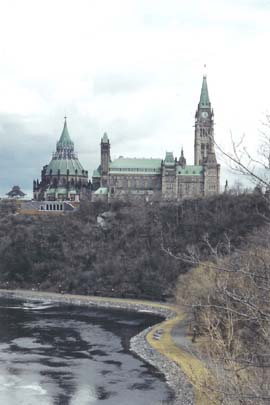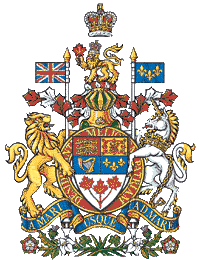|
|
Parliament
Hill: On July 1, Canada Day, there is no place I’d rather be than in Ottawa — among the tumultuous, exuberant crowd on Parliament Hill. I love the friendly crush of the approximately hundred thousand people waving flags, smiling, and bedecked in red-and-white hats, capes, shirts, and maple-leaf decals. The crowd surges forward as an elegant horse-drawn carriage escorted by a mounted contingent of RCMP brings the Governor General to the Hill. Musicians and dancers perform both on the official stage and as buskers dotted throughout the crowded streetscape with the sounds reverberating from the parliament buildings. I get goose bumps as the Snow Birds roar over the Peace Tower in perfect wing-tip to wing-tip precision. It feels good to park our normal Canadian reserve and let forth with an unabashed outpouring of national pride.
The doorway of the East Block showing the Parliament Buildings' whimsical Gothic architecture |
|||
Parliament Hill is the perfect place for this exuberant display of patriotism, for it is far more than just a hill and three large sandstone buildings. This spot is where our nation's history has been written. I often dream of having a time machine and watching from the cliffs as the early explorers sweated up the Ottawa River on their way into the interior of this vast land. And I would love to have seen these magnificent Gothic spires rising from this barren hilltop to form the parliament of the Colony of Canada. As Ottawa was little more than a rough-and-tumble frontier settlement at that time, the magnificent structures completed in 1866 with their soaring towers, flying buttresses, vaulted roofs, and pointed arches must have appeared just a little out of place. Actually, one journalist summed it up perfectly, “Ottawa is a small town with incongruously beautiful buildings crowning its insignificance.” But Ottawa and Canada have come a long way since those days. The Fathers of Confederation met and debated in the chambers of these buildings. And then on July 1, 1867, when the colonies of Nova Scotia, New Brunswick and Canada joined together to form the Dominion of Canada, the Hill witnessed a celebration as had never before been seen in Ottawa. And the tradition of grand birthday bashes has continued to this day. Since then, these sturdy sandstone walls have witnessed the conducting of the affairs of state, through war and peace, of a tiny colony that became a nation unto itself and a multicultural world leader. “The Hill” is indeed the heart and soul of Canada. I also love to visit it on quieter days, for there is so much to see. The resplendent Gothic architecture is almost overwhelming — these buildings have been described as the “finest pile of stones in Canada.” The Centre Block contains the House of Commons and the Senate and it is always entertaining to watch a raucous Question Period when the Honourable Members strive to upstage each other. The circular Parliamentary Library with its magnificent flying buttresses is considered the architectural gem of Canada, although Canada's first prime minister Sir John A. Macdonald disagreed; he thought it belonged to the “cowbell style” of architecture. The lofty and graceful Peace Tower that is perhaps the most recognized structure in Canada contains an observation deck and the Memorial Chamber. The latter commemorates those who died in the First World War and has been called the “holiest place on Canadian soil.” But my favourite is the East Block with its rich sandstone walls, the roof adorned with fancy wrought-iron cresting and the southwest tower with its caricature frowning face. In this impressive edifice, four rooms have been restored to their Victorian splendour. The original Cabinet Room — or Privy Council Chamber — is a place of powerful history for every Cabinet from Confederation until 1976 sat around its large table making important decisions that led to great moments in Canadian Parliamentary history: women winning the vote; the trans-Canada railway that physically united the country being built; the very contentious enforcing of conscription during the two great wars; the signing of a new Constitution in 1982. The Hill is also a fascinating venue for art. Many of the works are in prominent places like the 10 imposing murals in the Senate depicting scenes from the First World War, the delicate stained glass windows in the House of Commons featuring provincial flowers and the imposing paintings of British kings and queens in the Senate foyer. But tucked away in obscure nooks and adding a wonderful lightness — and almost eccentric quality — to these otherwise formal and grandiose surroundings are my favourites: hundreds of stone carvings in the form of gargoyles, animals, grimacing grotesques; and the sculpted likenesses of well-known Canadian politicians. When I am in a pensive mood and the weather is fine, I like to wander behind the Centre Block. As the sun sinks lower and the light turns to a golden yellow, I rest on a sun-warmed slab of granite beneath one of the stalwart bronze statues that stand there in testament to Canadian political life. I close my eyes and reflect on the significance of this place while hearing in my mind some of the great Canadian parliamentary voices: the rich Irish lilt of Thomas D’Arcy McGee; the feisty Scottish brogue of Sir John A. Macdonald; the heroic and pioneering proclamations of Agnes Macphail ; the fiery oratory of John Diefenbaker; or the bold eloquence of Pierre Trudeau. The Hill is a special place in all seasons, but for me the very best moment comes on the evening of July 1 — Canada Day — when dusk has fallen and the crowd is hushed in anticipation. Suddenly spectacular fireworks explode, lighting up the sky and silhouetting the soaring Gothic spires. At that moment, there is nowhere else in the world I would rather be. |
|
|||
If you Go
|
||||
